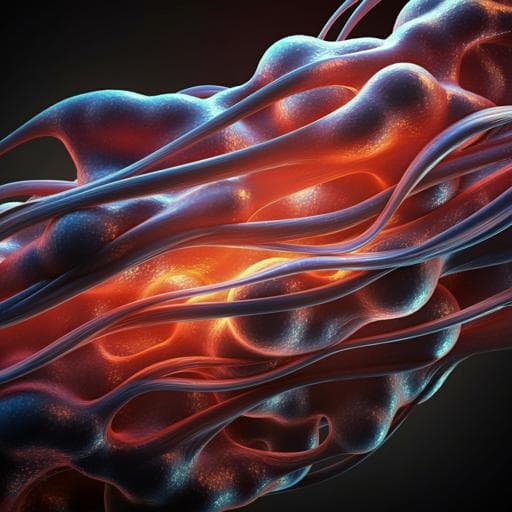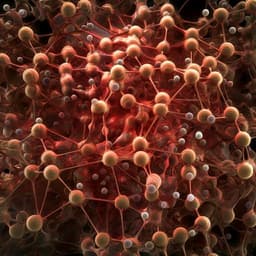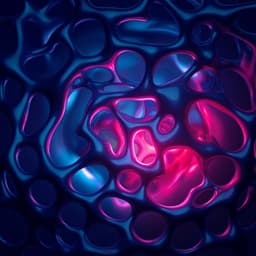
Engineering and Technology
Bio-inspired self-healing and anti-corrosion waterborne polyurethane coatings based on highly oriented graphene oxide
L. Wang, X. Wang, et al.
This groundbreaking research by Lin Wang and colleagues presents a self-healing, anti-corrosion waterborne polyurethane coating enhanced with graphene oxide. With remarkable mechanical properties and outstanding performance in harsh environments, this innovative biomimetic solution offers a robust protective layer for steel substrates.
~3 min • Beginner • English
Introduction
Steel, particularly carbon steel, is widely used due to low cost and high strength but suffers from poor corrosion resistance, especially in chloride-rich environments where water and oxygen facilitate corrosion. Protective coatings must both isolate metal from corrosive media and minimize damage when breaches occur. Traditional coatings lack active repair and are costly to maintain. Inspired by biological passive-damage active-repair, self-healing anti-corrosion coatings based on reversible interactions can extend service life. Waterborne polyurethane (WPU) is attractive for safety and adhesion but its hydrophilicity and low crosslink density reduce corrosion resistance. Graphene and graphene oxide (GO) nanosheets offer barrier properties and mechanical strength, but single-layer graphene coatings can exacerbate localized corrosion due to defects; thus, well-dispersed nanocomposites are preferable. Bio-inspired layered “brick-and-mortar” architectures and evaporation-induced self-assembly can impart high orientation and effective barriers. The study aims to design a self-healing, highly oriented WPU/GO coating with strong mechanical performance, dual (thermal and NIR) self-healing, and superior anti-corrosion protection.
Literature Review
Prior studies show that graphene-based barriers can protect metals but defects in CVD graphene may accelerate localized corrosion, highlighting the need for defect-minimized nanocomposite coatings. Uniform dispersion and orientation of nanosheets in polymer matrices are critical to barrier performance. Bio-inspired nacre-like architectures with layered alignment yield tortuous ion pathways and enhanced corrosion resistance. Conventional alignment methods (magnetic fields, electrophoretic deposition) are complex and energy intensive; evaporation-induced self-assembly and shear processing (spray/roll coating) can generate smectic, highly oriented layers at scale. Dynamic polymer networks with reversible bonds confer self-healing, and waterborne polyurethanes with dual dynamic networks have improved, recoverable properties. GO-functionalized systems and nanocontainers for inhibitor delivery have also exhibited improved corrosion protection and self-healing in epoxy and PU matrices. These insights motivate integrating dynamic-bond WPU with oriented GO via scalable roll-coating to achieve combined mechanical robustness, self-repair, and anticorrosion.
Methodology
Materials: WPU synthesized from polycaprolactone diol (PCL, Mn~2000), HMDI, 2,2-bis(hydroxymethyl)butyric acid (DMBA), 4,6-diaminopyrimidine, and dibutyltin dilaurate (DBTDL) in acetone/DMF under N2 via one-pot polycondensation, followed by neutralization with triethylamine, emulsification with water, solvent removal, and film formation. GO prepared by modified Hummers' method (H2SO4/KMnO4 oxidation of graphite, controlled addition of water and H2O2, acid washing, dialysis) to yield low-defect GO dispersion.
Coating preparation: Substrate Q235 carbon steel mechanically polished, ethanol-cleaned, plasma-treated. GO (0.075 g) dispersed in DMF (2 mL, sonicated 20 min) mixed with WPU (3.69 g) using high-speed disperser (2000 rpm, 2 min), defoamed, and applied by bar roll-coater (gap ~15 µm, line speed 150 mm s−1). Three coats applied with ~12 h intervals; final cure 80 °C for 24 h and 7 days at room temperature. GO loading 2.0 wt%. Roll-coating produced lamellar, flat-oriented GO (WPU-GOLM). A brush-applied random structure coating (WPU-GORM) and neat WPU were prepared as controls. Final dry thickness ~50 ± 5 µm.
Characterization: FT-IR (including variable-temperature and 2D-COS) and 1H NMR to confirm WPU structure and hydrogen-bond dynamics; UV-Vis of GO; AFM for GO thickness and surface roughness; SEM/OM for morphology and cross-sections; DLS/Zetasizer for WPU particle size and zeta potentials of GO and WPU-GO dispersions. Mechanical testing of WPU elastomer with ISO 37-3 dumbbell specimens (25 °C) for stress–strain, toughness, puncture resistance, notch tolerance, and fracture energy (Greensmith method). Self-healing evaluation via scratch closure and re-tensile after thermal treatment (50 °C) and photothermal NIR (808 nm) irradiation.
Electrochemical testing: EIS in 3.5 wt% NaCl (pH 7, 25 °C) over 2–10 days, reporting Nyquist and Bode plots, |Z| at 0.01 Hz, phase angles, equivalent circuit fitting (Rs, Rc, CPEc, Rct, CPEdl, Zw) to extract Rc, Qc, and Rct. Large-area (4×4 cm) immersion in 5 wt% NaCl up to 246 h with visual, OM, and AFM assessment. SVET on defected coatings (10×10×2 mm plates) in 3.5 wt% NaCl to map local anodic/cathodic current densities and probe self-healing after thermal treatment.
Key Findings
Polymer and microstructure: WPU dispersion exhibited bimodal particle size with ~26.85% at 10 nm and ~27.26% at 11 nm; transparent films formed. Variable-temperature FT-IR/2D-COS showed temperature-dependent shifts of C=O bands (1705→1732→1741 cm−1), evidencing dissociation/recombination of hydrogen bonds. GO nanosheets were layered (AFM thickness ~2.43 nm, ~few-layer), with UV peaks at 232 and 299 nm. Zeta potentials: GO −33.7 ± 1.283 mV, WPU-GO dispersion −39.9 ± 0.860 mV (stable dispersions). Cross-sections confirmed similar thicknesses (~52–53 µm) among coatings.
Mechanical and healing performance (WPU elastomer): Tensile strength ~39.89 MPa, elongation at break ~1827.65%, toughness ~300.3 MJ m3; fracture energy Gc ~146.57 kJ m−2. Puncture resistance for ~0.8 mm sheets: displacement ~46.3 mm, force ~109.7 N. Notch tolerance: ~1 mm notch, stretching to ~1000% without crack propagation. Surface scratches vanished after ~3 h at room temperature; cut samples healed and stretched to ~600% strain without notch growth after 24 h. At 50 °C, healing restored tensile behavior nearly to original within 12 h.
Electrochemical barrier (EIS): High-frequency phase angle near −90° indicates capacitive behavior. WPU phase angle: 80.7 ± 0.535° initially, decreasing to 78 ± 0.572° by day 10. WPU-GOLM: stable 86.5–87.4 ± 0.294°, near ideal capacitive behavior; WPU-GORM intermediate. Low-frequency impedance |Z0.01Hz|: WPU 4.405×10^7 Ω·cm2 (day 2) dropping to 3.191×10^6 Ω·cm2 (day 10). WPU-GORM and WPU-GOLM initially 1.068×10^8 and 1.233×10^8 Ω·cm2; WPU-GOLM retained 3.771×10^7 Ω·cm2 after 10 days (about one order of magnitude above WPU). Protection efficiency vs neat WPU at day 10: WPU-GORM 58.8%, WPU-GOLM 74.2%. Equivalent circuit fits showed higher coating resistance Rc and lower coating capacitance Qc for GO-containing coatings, with WPU-GOLM best; charge transfer resistance Rct: WPU-GOLM 1.581×10^7 ± 7.995×10^1 Ω·cm2, WPU-GORM 1.172×10^7 ± 2.005×10^2 Ω·cm2, WPU 5.659×10^5 ± 3.103×10^1 Ω·cm2.
Large-area immersion (5 wt% NaCl): WPU blistering by 38 h and full failure by 246 h. WPU-GORM and WPU-GOLM maintained protection through 188 h; at 246 h, WPU-GORM showed pitting without blistering/peeling; WPU-GOLM showed no visible corrosion. After 246 h, OM revealed heavy corrosion products on WPU surface; WPU-GOLM surface remained intact. AFM roughness of steel after coating removal: WPU-GOLM 4.22 nm (smoother than WPU-removed substrate).
NIR photothermal and self-healing (WPU-GOLM): Under 808 nm irradiation, surface temperature rose to 124.75 °C in 5 s and 132.8 °C in 30 s; WPU showed negligible heating. Cyclic tests showed rapid heating (to ~124.7 °C in ~5 s) and rapid cooling after laser off (to ~62.0 °C by ~9.34 s and ~37.6 °C by ~9.5 s), indicating high photothermal conversion and thermal conductivity. NIR-triggered repair closed small holes in 5 s, mesopores in 10 s, and larger holes in 30 s.
SVET corrosion mapping: In 3.5 wt% NaCl, WPU defect anodic current density increased 16→27 μA·cm−2 over time; after 14 h, anodic ~24 μA·cm−2 with cathodic ~8 μA·cm−2 indicating progressing corrosion and detachment risk. WPU-GORM: anodic 11→16 μA·cm−2 (2→7 h), ~24 μA·cm−2 at 14 h with no cathodic current. WPU-GOLM: slight anodic increase 8.8→9 μA·cm−2 (2→7 h), ~14 μA·cm−2 at 14 h, with no cathodic current detected. Thermal healing of WPU at 60 °C for 6 h after 24 h immersion reduced SVET currents close to noise, indicating effective repair.
Mechanism: Highly oriented GO “brick” alignment via roll-coating and interfacial hydrogen bonding creates long, tortuous diffusion paths and cation-selective behavior under local pH shifts, reducing Cl−/OH− ingress and suppressing electrochemical reactions. Reversible hydrogen-bond arrays dissipate energy and enable thermal/NIR self-healing, enhancing damage tolerance and maintaining barrier integrity.
Discussion
The study addresses the need for coatings that both isolate substrates from corrosive media and autonomously repair defects. By engineering a WPU matrix with multiple dynamic interactions (covalent, reversible hydrogen bonds, ionic, hydrophilic groups) and integrating well-dispersed, lamellar, highly oriented GO via roll-coating, the coating simultaneously achieves toughness, damage resistance, and dual-mode (thermal and NIR) self-healing. Oriented GO and interfacial hydrogen bonding enhance mechanical integrity and generate a tortuous pathway that impedes ion/water diffusion, reflected in higher |Z0.01Hz|, near-ideal capacitive phase angles, elevated Rc and Rct, and superior performance in long-term immersion and SVET. The cation-selective behavior of negatively charged GO under alkaline cathodic conditions further restricts corrosive ion transport. Photothermal conversion by GO enables rapid, localized repair within tens of seconds, overcoming limitations of thermal-only healing and allowing precise, on-demand restoration. Collectively, the findings confirm that nanosheet orientation and supramolecular bonding are synergistic levers to produce robust, smart anticorrosion coatings suitable for harsh environments.
Conclusion
A scalable, bio-inspired strategy was demonstrated to fabricate multifunctional WPU/GO coatings with highly oriented lamellar structures formed by roll-coating and stabilized by interfacial hydrogen bonds. The resultant materials exhibit exceptional elastomeric mechanics (strength ~39.9 MPa, strain ~1828%, toughness ~300 MJ m3, Gc ~146.6 kJ m−2), excellent puncture and notch tolerance, and efficient self-healing under mild heating (50 °C) and rapid, localized repair under NIR within 30 s. Electrochemical tests confirm markedly improved barrier properties over neat WPU, with higher low-frequency impedance, phase angles close to −90°, elevated Rc and Rct, and sustained protection during prolonged saline immersion, corroborated by SVET mapping and large-area exposure. The approach provides a generally applicable route to high-performance, smart anticorrosion coatings for metals via simple, energy-efficient processing.
Limitations
Related Publications
Explore these studies to deepen your understanding of the subject.







